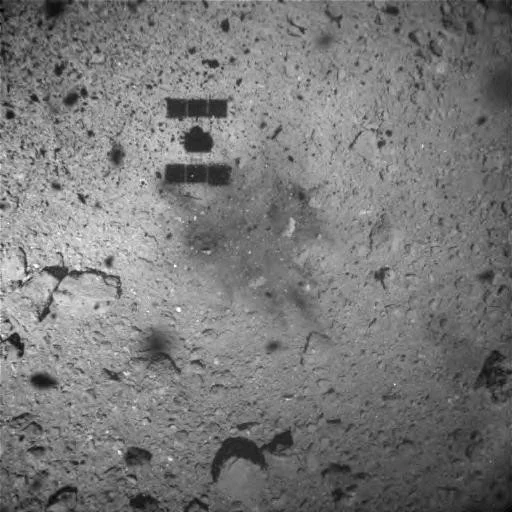Modeling Ice in Asteroids
The Occator crater on asteroid Ceres. The NASA Dawn spacecraft identified ice within the top meter of the surface. Ice likely exists here because Ceres has a very low thermal inertia, small axial tilt, and a semi-major axis at 2.77 AU. Low temperatures help prevent ice sublimation. Credit: NASA/JPL-Caltech/UCLA/MPS/DLR/IDA.
A key appeal for processing water from asteroids as opposed to the Moon is the low delta-V required to get to and from them. However, this assumes that water rich asteroids come near Earth. Scientists from the Planetary Science Institute have developed an analytical model that can help estimate if some near-Earth objects (NEOs) contain water ice.
The closer an asteroid is to the Sun (smaller semi-major axis), the hotter its surface. This higher temperature causes interior ice to sublimate quicker. Credit: Schorghofer 2018 et al., Figure 2b.
Asteroids are mainly composed of rocks, dust, and ice. Nearby asteroids formed during the creation of the Solar System over 4.5 billion years ago. Aside for ice bearing asteroids, the composition of asteroids has remained unchanged since their creation. Ice bearing asteroids experience sublimation of their water over millions of years. This is due to temperature of the asteroid, where asteroids closer to the Sun have a higher rate of losing ice.
This means that most asteroids close to the Sun have no ice, while asteroids further out can contain high concentrations ice. There is a boundary where this split occurs, yet exceptions to this rule likely exist. Understanding the boundary and exceptions are important for asteroid mining firms who want an accessible water source for propellant production.
As a quick aside, asteroids can contain water in two forms: ice and hydrated minerals. Ice is easy to process (via melting), but is hard to find in objects near the Sun. Conversely, hydrated minerals are more difficult to process (via high temperature baking), but are plentiful on nearby asteroids. Ideally, asteroid miners would process ice bearing NEOs. However, these are thought to be unusual, hence TransAstra's development of their spalling system for processing water from hydrated material.
Ice bearing asteroids closer to the Sun lose their ice quicker than being further away. The size of the asteroid plays a role in how long it will take before most of the ice will be sublimated away. The dotted lines indicate the desiccation time of ice within the very core of these objects. Interior ice is able to survive longer because the asteroid regolith is highly insulative. Credit: Schorghofer 2018 et al., Figure 7a
Scientists from the Planetary Science Institute developed an analytical model to help identify this ice/no-ice boundary. The model is based on understanding how much time it takes the ice in an ice rich asteroid to be fully sublimated (desiccation time). Generally, the hotter the object's surface temperature, the quicker the ice will sublimate (shorter desiccation time). Objects over a certain size, however, are expected to retain some ice within their interior due to the regolith being a good insulator.
Temperature is the defining factor for how quickly ice sublimates off asteroids, which is mostly based on semi-major axis (i.e. max distance to the Sun). Thermal inertia and axial tilt also play a role. For instance, ice loss would be more dramatic on an asteroid that retains more heat and has a high axial tilt.
The larger the asteroid, the larger amount of time it will take for ice to be sublimated away. For many large asteroids in the mid and outer asteroid belt, it will take billions more years to fully lose their ice. Credit: Schorghofer 2018 et al., Figure 7b.
Bringing this together, the larger, younger, and colder an asteroid is, the more ice it will likely contain. Non-metallic objects in the mid/outer main asteroid belt (over 2.5 AU from the Sun) with diameters over 14 km are expected to contain ice. A few thousand known objects fit these constraints.
It will be much more rare for a NEO to contain ice, but it is still possible based on this model. The larger the NEO, the more likely it could contain ice. For a NEO less than 1 km to contain ice in its interior, it would have to have a semi-major axis greater than 2.8 AU, a very low thermal inertia, a stable and small axial tilt, and a young age due to a modern breakup from an ice rich parent. Within such a case, subsurface ice would likely exist in the polar regions.
This analytical model is an excellent tool for evaluating potential targets for asteroid miners. Finding nearby, low eccentricity asteroids with ice would be a boon for early exploration missions. More asteroid observations and models like this will improve our understanding of our celestial neighbors.
References
Schörghofer, Norbert, and Henry H. Hsieh. "Ice loss from the interior of small airless bodies according to an idealized model." Journal of Geophysical Research: Planets 123.9 (2018): 2322-2335. DOI: 10.1029/2018JE005568.









